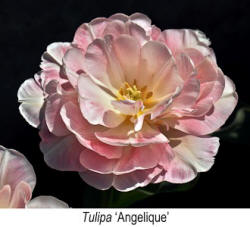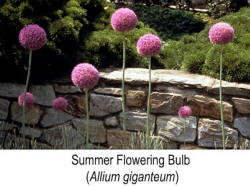As a general rule, bulbs should be
planted at a depth about 2.5 or 3 times their height. In
other words, if a tulip bulb is 2 inches tall, you should
dig a hole about 5 to 6 inches deep for it. Planting too
shallow may expose the bulb to cold winter temperatures
while planting too deep can force the plant to push its way
up through too much soil resulting in a weakened plant.
A. Planting Spring Flowering Bulbs -
Tulips,
daffodils,
hyacinths and other
bulb plants that bloom in the early spring will need to be
planted in the autumn of the year. Most of them need to be
exposed to a certain number of
 days of temperatures below 40
degrees before they will develop the precursors of stems and
flower buds. If they do not get these conditions, they will
not flower the next spring. Check with your local
Extension
Service
office or local nurseries to see if this is a problem in
your area. Some regions of the
Southern United States do not receive
enough cold to trigger flowering in these bulbs.
days of temperatures below 40
degrees before they will develop the precursors of stems and
flower buds. If they do not get these conditions, they will
not flower the next spring. Check with your local
Extension
Service
office or local nurseries to see if this is a problem in
your area. Some regions of the
Southern United States do not receive
enough cold to trigger flowering in these bulbs.
B. Summer Flowering Bulbs - As mentioned earlier, there are a whole
bunch of different types of plants that are lumped into the
category of "bulbs." Several true bulbs such as the
hardy lilies (Lilium) or ornamental onions (Allium)
need to be planted in the fall since they too need a
chilling effect before they
will bloom.
 Many of the other so-called bulbs that bloom in the summer
including
cannas,
gladiolus,
tuberous begonias, caladium and
dahlias may be planted in the spring. In fact, these types
of plants are generally not hardy in northern gardens and
will need to be dug up and stored each autumn. Many of them
may even be purchased in the spring as container plants
which have been grown in the greenhouse.
Many of the other so-called bulbs that bloom in the summer
including
cannas,
gladiolus,
tuberous begonias, caladium and
dahlias may be planted in the spring. In fact, these types
of plants are generally not hardy in northern gardens and
will need to be dug up and stored each autumn. Many of them
may even be purchased in the spring as container plants
which have been grown in the greenhouse.



